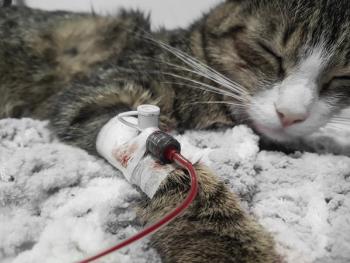
IMPA (immune-mediated polyarthritis) in dogs (Proceedings)
Idiopathic, non-infectious, non-erosive immune-mediated polyarthritis (IMPA) is the most common immune-mediated arthritic condition in the dog, resulting in effusion, pain, and decreased range of motion in multiple joints.
Idiopathic, non-infectious, non-erosive immune-mediated polyarthritis (IMPA) is the most common immune-mediated arthritic condition in the dog, resulting in effusion, pain, and decreased range of motion in multiple joints. Although considered a Type III hypersensitivity disorder, an underlying etiology is not often found. Treatment of IMPA requires both treatment of the underlying immunologic trigger, if identified, and treatment of joint inflammation. Failure to achieve this goal may result in persistence or recurrence of clinical signs. Glucocorticoids are the most widely used treatment for IMPA in dogs. Although initial response rate to glucocorticoids has been reported as high as 81%, side effects ranging from polyuria, polydipsia, and polyphagia to diabetes mellitus, urinary tract infections, pyoderma, and breakdown of collagen in tendons and ligaments are prevalent. As a result, alternative or combination therapy is often sought, either to avoid complications associated with glucocorticoid therapy or for treatment of unresponsive disease.
Classifications
Immune-mediated polyarthritis (IMPA) can cause either erosive or non-erosive change of articular cartilage. Classifications of polyarthritis consist of both infectious and non-infectious (inflammatory); non-infectious, inflammatory polyarthritis can be further broken down into sub-categories of non-erosive and erosive. Types of erosive polyarthritis can include: rheumatoid arthritis, polyarthritis of Greyhounds or Felty's syndrome (rheumatoid arthritis, splenomegaly, neutropenia). Non-erosive polyarthritis includes: idiopathic (type I -no underlying disease, type II - reactive, type III – enteropathic, IV – neoplasia related), systemic lupus erythematosus (SLE), vaccine-associated, drug-induced (secondary to sulfa drugs), polyarthritis/polymyositis, polyarthritis/meningitis, polyarthritis nodosa, Sjogren syndrome (arthritis, keratoconjuctivitis sicca, xerostomia), arthritis of adolescent Akita Inus, Shar Pei fever syndrome (amyloidosis, hock joint involvement), or lymphocytic-plasmacytic gonitis.
Mechanisms/causes
Due to an immunologic trigger in the body, immune complexes are created and deposited within the basement membrane of the synovium. Through activation of the complement cascade, inflammatory cells, including neutrophils and macrophages, are recruited to the site of inflammation. The end result, after phagocytosis of the immune complexes, is the release of nitric oxide, free radicals, and proteases which cause tissue destruction. The cause is unknown but most likely results from immunologic mechanisms.
Signalment
When the conditions occur that a primary or underlying disease can not be identified it is deemed idiopathic. This type of diagnosis can be made only after ruling out the other possible causes of arthritis. It is most commonly seen in large and small breed dogs but is uncommon in cats. German shepherds, Doberman pinschers, retriever breeds as well as spaniels, pointers, Toy Poodles, Lhaso Apsos, Yorkshire terriers and Chihuahuas are over represented. The mean age and range is typically from young to middle aged dogs; incidence peaks at 2.5-4.5 years of age however any age can be affected. Males and females are equally represented.
Clinical signs
Clinical features of IMPA include stiffness and lameness most commonly, as well as pyrexia, lymphadenopathy, inappetence, lumbar spinal pain, depression, exercise intolerance, and lethargy. Decreased range-of-motion, effusion, heat, and pain upon manipulation of affected joints may be appreciated. Bilaterally symmetrical joint involvement is common with IMPA. Diarthrodial joints most often affected (in descending order) are the carpi, tarsi, stifles, and elbows-all may be affected. At times these signs are cyclic in nature. Many patients are seen because of decreased appetite or because of a fever of unknown origin. This can also be present with no palpable joint effusion or localized pain.
Diagnosis
Diagnosis of IMPA is based on a significant increase in the synovial fluid cell count within affected joints; however a complete diagnostic work-up is recommended including a complete blood cell count (CBC), serum biochemical testing, urinalysis, thoracic radiographs, abdominal ultrasound, joint radiographs, arthrocentesis (including cytology and culture), and serologic testing for infectious agents. Testing for antinuclear and rheumatoid factor autoantibodies (ANA and RF) is commonly performed. However, unlike in human beings, these tests are not sensitive or specific for IMPA. A positive ANA or RF titer in the canine patient may result from any chronic inflammatory disease that leads to persistent antigen exposure and production of immune complexes. ANA titers are more sensitive when the test is reserved for dogs in which systemic lupus erythematosus (SLE) is suspected. An underlying immunologic trigger for IMPA is rarely found.
Results from the CBC commonly show neutrophilia although neutropenia is occasionally noted and some dogs show completely normal CBC's. Radiographs are often times normal or limited to joint or periarticular swelling with no boney or cartilage abnormalities. Synovial fluid is often times thin and may be turbid. The mucin clot test results are usually normal or show a slight decrease. Nucleated cell counts are increased (4,000 to 370,000 cells/µl) and nondegenerate neutrophils dominate (usually <80%). Patients that present with less severe cases or that have begun being treated (particularly with corticosteroids) may have a lower WBC and a lower percentage of neutrophils (30-80%). Blood, urine and synovial fluid are typically negative for bacteria and Mycoplasma.
Medical treatment
Treatment of IMPA requires both treatment of the underlying immunologic trigger, if identified and treatment of joint inflammation. Failure to achieve this goal may result in persistence or recurrence of clinical signs. Numerous regimens have been proposed, and involve monotherapy or combination therapy with glucocorticoids, cytotoxic drugs, and newer immunomodulating drugs such as cyclosporine or leflunomide. Efficacy of individual drugs or dosages is difficult to assess as combination therapy is common and controlled prospective trials are unavailable. Regardless of treatment regimen chosen, efficacy is best assessed by both clinical signs and, most importantly, by joint fluid analysis. There are inconsistent recommendations as to how often arthrocentesis should be performed. It is recommended that the total nucleated cell count remain below 4.0 X 109 cells/L before reducing or discontinuing therapy. In addition, because side effects associated with treatment are common, monitoring clinical signs, hematology, and serum biochemical profiles is important.
Glucocorticoids are the most widely used treatment for IMPA in dogs. Although initial response rate has been reported as high as 81%, side effects are common. Adverse effects range from polyuria, polydipsia, and polyphagia to more serious complications such as diabetes mellitus, urinary tract infections, pyoderma, and breakdown of collagen in tendons and ligaments. As a result, alternative or combination therapy is often sought, either to avoid complications associated with glucocorticoid therapy or for treatment of unresponsive disease.
Common drugs used in the treatment of IMPA also include azathioprine or cyclophosphamide however these drugs are quickly becoming replaced as they historically have less desirable side-effects which are often times detrimental to the patient.
Leflunomide is a newer immunomodulating agent that is structurally unlike any other immunomodulating drug. It has been proven effective in experimental models and clinical cases of rheumatoid arthritis and other immune-mediated disease in both people and dogs. Side effects including gastrointestinal upset and anemia have been documented in dogs at doses above 4 mg/kg/day. When used in clinical cases at 4 mg/kg/day, minimal side effects were observed. Therefore, leflunomide is an attractive alternative to glucocorticoids for treatment of IMPA.
Nursing care
Although this is often times an out-patient health care issue the more severe cases can be quite critical. There is also a fair amount of client education which should take place for owners of these pets to be able to make good observations and provide appropriate supportive care at home.
For in hospital patients it may be indicated to enlist a physical therapy plan which may include passive range of motion (POM) exercises, massage therapy and/or swimming (treadmill) for the more severe cases. As well as any supportive nursing care necessary to treat the concurrently existing clinical signs.
Owners should be educated on limitation of activity, dietary management of weight as well as any rehabilitation therapy or pain management that can provide good quality of life for these patients.
Conclusion
Although patients diagnosed with IMPA must be treated for the duration of their life more viable treatment options are becoming available that can ensure a high quality of life.
References
1. Goring RL et al, Immune mediated arthritis. In: Bojrab, MJ, ed. Disease mechanisms in small animal surgery. Philadelphia: Lea % Febiger, 1993: 742-750.
2. Pedersen NC. Joint diseases of dogs and cats. In Ettinger S.J. ed Textbook of veterinary internal medicine 3rd ed Philadelphia: Saunders, 1989:2329-2377.
3. Nelson et al,Joint disorder, In Small animal internal medicine 2nd ed.Missouri: 1998: 1076-1088.
4. Use of Leflunomide in Dogs with Polyarthritis 2009 SA. Colopy DVM, DACVS, T Baker BS, Peter Muir BVSc, MVetClinStud, PhD, DACVS
Newsletter
From exam room tips to practice management insights, get trusted veterinary news delivered straight to your inbox—subscribe to dvm360.




